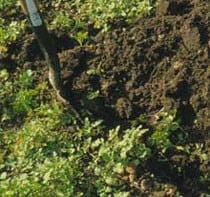Shop
-
Plants
By type
Seasonal plants
-
Bulbs
Bulbs by type
-
Indoor plants
Indoor plants by type
By size
By light
-
Pots
Outdoor pots
By material
By shape
Inspiration
-
Tool shed
Garden equipment
- Crocus collection
- Compost, bark & mulch
- Fertilisers & weed control
- Pest control
- Compost bins & wormeries
- Irrigation & watering
- Water butts
- Garden clothing & accessories
- Garden tidy
- Garden storage
- Boot room & fireside
Plant protection
Garden tools
Potting & propagating
-
Outdoor living
Outdoor living
Furniture
Lighting
Birdcare & wildlife
-
Furniture
Furniture sets
Furniture accessories
Garden seating
By material
- Gifting
-
Offers
Plant offers
Product offers
-
Inspiration
Garden Style Inspiration
-
Advice
Seasonal plant advice




 Apart from adding organic matter, some green manures offer other benefits. For example, deep-rooting green manures such as alfalfa, red clover and lupins will use nutrients from deep in the soil beyond the reach of many annual crops. Then when the green manure decomposes in the soil, the nutrients are deposited in the upper layers where follow-on crops and plants can utilise them. Similarly, leguminous plants such as beans, lupins, clover and fenugreek, have special nodules on their roots filled with 'nitrogen-fixing' bacteria that can take nitrogen from the air and make it available to the green manure. Again, when the green manure decomposes, the nitrogen then becomes available to follow-on crops and plants.
Apart from adding organic matter, some green manures offer other benefits. For example, deep-rooting green manures such as alfalfa, red clover and lupins will use nutrients from deep in the soil beyond the reach of many annual crops. Then when the green manure decomposes in the soil, the nutrients are deposited in the upper layers where follow-on crops and plants can utilise them. Similarly, leguminous plants such as beans, lupins, clover and fenugreek, have special nodules on their roots filled with 'nitrogen-fixing' bacteria that can take nitrogen from the air and make it available to the green manure. Again, when the green manure decomposes, the nitrogen then becomes available to follow-on crops and plants.